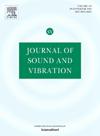源提取的降阶参考技术中的源枚举
IF 4.3
2区 工程技术
Q1 ACOUSTICS
引用次数: 0
摘要
在源提取中,当源的真实数目未知时,源枚举是必不可少的。在降低等级引用(一致性)技术中就是这种情况,在这种技术中,使用的引用数量大于源的数量。源数量的估计是准确提取源的关键。然而,在参考技术的框架内,这个不适定逆问题在文献中没有得到充分的解决。本文在为文献中所有参考技术提供了统一的形式之后,提出了适用于所有参考技术的三种备选源枚举方法:针对饱和模型的直接似然比检验(LRT)、参数自举技术和交叉验证方法。基于仿真数值数据、真实声音实验数据和电机实际工业数据,对三种方法进行了对比研究。研究结果揭示了两个重要发现。首先,光谱分析中使用的快照(光谱窗口)数量显著影响三种方法的性能,并且对于相同数量的快照,它们的表现不同。其次,参数自举被证明是最好的方法在估计精度和鲁棒性方面关于使用的快照数量。本文章由计算机程序翻译,如有差异,请以英文原文为准。
Source enumeration in reduced-rank reference techniques for source extraction
In source extraction, source enumeration is essential when the true number of sources is unknown. This is the case in reduced-rank reference (coherence) techniques, where a number of references higher than the number of sources is used. The estimation of the number of sources is critical for accurate source extraction. However, this ill-posed inverse problem has not been sufficiently addressed in the literature within the framework of reference techniques. In this paper, after providing a unified formalism for all reference techniques in the literature, three alternative source enumeration methods applicable to all reference techniques are presented: a direct likelihood ratio test (LRT) against the saturated model, a parametric bootstrap technique, and a cross-validation approach. A comparative study is conducted among the three methods based on simulated numerical data, real sound experimental data, and real industrial data from an electric motor. The results reveal two important findings. First, the number of snapshots (spectral windows) used in spectral analysis significantly affects the performance of the three methods, and they behave differently for the same number of snapshots. Second, parametric bootstrapping proves to be the best method in terms of both estimation accuracy and robustness concerning the number of snapshots used.
求助全文
通过发布文献求助,成功后即可免费获取论文全文。
去求助
来源期刊

Journal of Sound and Vibration
工程技术-工程:机械
CiteScore
9.10
自引率
10.60%
发文量
551
审稿时长
69 days
期刊介绍:
The Journal of Sound and Vibration (JSV) is an independent journal devoted to the prompt publication of original papers, both theoretical and experimental, that provide new information on any aspect of sound or vibration. There is an emphasis on fundamental work that has potential for practical application.
JSV was founded and operates on the premise that the subject of sound and vibration requires a journal that publishes papers of a high technical standard across the various subdisciplines, thus facilitating awareness of techniques and discoveries in one area that may be applicable in others.
 求助内容:
求助内容: 应助结果提醒方式:
应助结果提醒方式:


